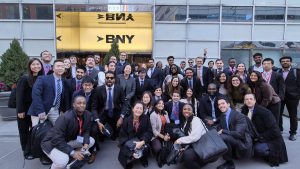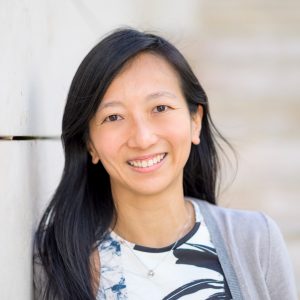The New York international module offers IESE MBAs a unique opportunity to immerse themselves in one of the world’s most dynamic business environments. Students engage with leading industry professionals, participate in company visits, and attend specialized lectures with a focus on global financial markets. David Teeters, Senior Lecturer in the Department of Financial Management, shares some highlights from the November module. If you have an interest in finance, this is not to be missed!
NYC International Module Day 1:
Amazing start to a full week of macrofinance in New York City!
Ajay R., Global Chairman at Barclays, kicked off with an outstanding global macro outlook, weaving a narrative of a strong US as an energy superpower continuing to enjoy a unipolar moment at the center of the IMFS architecture, despite internal politics. Ajay encouraged the students to focus on transmission mechanisms; macro realities matter more here than even geopolitical risk premia. Ahead of US presidential elections we dove into the implications of tariffs (resulting in losses for the rest of the world), as markets have learned to take Trump’s threats as negotiating tactics seriously (if not literally).
Brad Setser, senior fellow at the Council on Foreign Relations, walked us through the ’most important picture in macro’: the China shock of dramatically increased manufacturing trade surplus from ‘03-’07. Many of the resulting puzzles in international capital flows over the past two decades have yet to be resolved, and only will be fully understood through crisis. Brad stepped through a detailed decomposition of Chinese financial flows and the implications on global financial markets.
Joseph Wang, CIO at Monetary Macro and former senior dealer at the NY Fed, presented the IESE MBAs with a patient foundation of the inner workings of Federal Reserve monetary policy before turning to recent innovations and challenges. From discussions of SOFR, term premium and learning to interpret ‘Fed speak’, these lessons will inform our conversations with market participants all week long. Listening to Joseph tell his story of being the first on the desk at the NYFed to react to the September 2019 ‘repocalpyse’ offered a candid portrait of the realities of Fed crisis management.
Day 2:
Day 2 kicked off at Bloomberg and the pulse of the information flow at the heart of markets. Mark Dimont welcomed IESE with an overview of the powerful functionality of the Terminal. Duccio Pappadopulo discussed the future of Bloomberg with the ever increasing incorporation of AI into core functionality. Stephen Foxwell ended our morning with pithy insights drawn on his years of experience as executive editor at Bloomberg News and on the product side as to how Bloomberg works to guarantee the credibility and completeness of information.
Michael Story at PIMCO shifted our focus from macrofinance musings on models to understanding what this means for intermediation in the world of asset management. Going beyond the traditional framework of ‘edge’ via market timing / issue selection / portfolio construction, Mike stepped through both the alts framework of risk factors / premia as well as a more hedge fund focus on specific trades.
Matt Raimondi from Morningstar Sustainalytics introduced us to the world of ESG ratings and research as a key source of information to our decision-making process in support of sustainable investing. Matt shared his experiences from impact investing that it is not always a question of either one or the other, but that market beating returns can be achieved at the same time as social impact through our capital allocation process, with a clearly focused investment mandate and diligent project selection.
 Finally, the main event of the day: the historic US presidential election. Experienced media executive Alex Wallace drew a map for us to understand what exactly are the issues that are driving Americans to cast their vote on November 5.
Finally, the main event of the day: the historic US presidential election. Experienced media executive Alex Wallace drew a map for us to understand what exactly are the issues that are driving Americans to cast their vote on November 5.
Day 3:
Our journey to understand our international financial monetary system took us to the heart of the plumbing of markets today.
David Pollino, head of fraud prevention, Anne Louise Higgins, global head of cyber risk, and Sarthak Pattanaik, CFA, head of AI Hub, and the entire team at BNY generously welcomed us to a morning of insightful sessions looking at why Bank of New York Mellon is the embodiment of a Global Systemically Important Bank (G-SIB) as the bank of banks and its role in the settlement and safe-keeping of financial assets. If we often talk about the degree to which the world around us is financialized, the privilege to see the CTOC (cybersecurity technology operations control room) is the single best visualization to what exactly this means.
We then crossed the street in downtown New York City to Citi, where Josep Maria Farres i Martinez, global head of strategy for structured products, and Deirdre Dunn, head of rates at Citi and chair of the Treasury Borrowing Advisory Committee shared their experiences and perspectives both on the world of liquid US interest rate product (and the advice to the U.S. Department of the Treasury in the issuance of government debt, as well as to the Federal Reserve Board on monetary policy and regulation of our banking system) and the ever evolving massive world of financial derivatives (that creates financial instruments both to provide risk management solutions as well as access to different risk premier for end investors).
Finally, we ended our day back at home with the amazing IESE community in New York City, and a panel discussion with Hector Chifungo, FCCA, MBA, CSPO, Matthew Olive and Aditya Negi. Thank you!
Day 4:
Today we turned from macrofinance to focus on private markets, changing financial market structures, and a detour through financial market history.
Michael Brandmeyer, CIO at Goldman Sachs Asset Management, framed the evolution of market structure from traditional asset class investing in public markets to alts investing / private markets, tracing the narrative arc of his own career starting as a high yield EM PM at Goldman. The evolution of markets (and fees) from mature passive and active equity styles to the world of alts (as primary source of alpha) focused the students’ attention on the powerful model of private equity as change capital and the rapidly growing world of private credit.
Michael Rees, Co-President of Blue Owl Capital and Founder of Dyal Capital, continued the conversation with his experiences in private markets in opportunistically first founding an asset manager and from there creating a new market for investing in secondary GP stakes in hedge funds and private equity firms via a permanent capital vehicle. The students were once again reminded of the importance of relationships, reputation, and taking care of your people, as essentials in building a successful business.
 The next session was legendary Professor Aswath Damodaran of NYU. Reflections on his own 38 year career in teaching valuation at business school focused our understanding of how valuation methodology changes from crisis to crisis, following changes in business models and unit economics, as context for a discussion on ‘Beat Your Bot: Building Your Moat Against AI.’
The next session was legendary Professor Aswath Damodaran of NYU. Reflections on his own 38 year career in teaching valuation at business school focused our understanding of how valuation methodology changes from crisis to crisis, following changes in business models and unit economics, as context for a discussion on ‘Beat Your Bot: Building Your Moat Against AI.’
Michael Mueller, MD at Third Point LLC closed our 4th day with a candid round of Q&A on life in markets and as a hedge fund manager, and the necessary intellectual curiosity as the basis for successful short-selling.
Day 5:
After such an intense week, Friday presented the students with the opportunity of a guided tour of the financial history that was created in downtown New York, alongside the eponymous Wall Street.
With final sessions to tie the many strands of finance that we have worked to weave into a tapestry of understanding the current state and future possibilities of our international monetary financial system, we headed to the United Nations, for some reflection in the General Assembly Hall before a final conversation with Jose Antonio Nunez Poblete of the UN Pension Fund to discuss the importance of managing funds responsibly to support their colleagues in their global efforts.
One final thank you to all who so generously contributed to making this week a success, and best wishes to the students whose adventure in understanding our financial system has only just begun.
*You can find the full posts on Linkedin.
Pursue your dream MBA! Take these next steps today:










